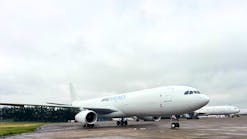With winter just around the corner, many owners are already starting to think about cold-weather preparation. There are different considerations when preparing an aircraft for winter depending on whether the owner/operator plans to operate the aircraft during the winter months or just store it. This article will focus on tips you can use to help your customers prepare for this winter season.
When preparing an aircraft for winter operation, your first step should be to refer to the applicable maintenance manuals. They will spell out specific maintenance and inspection items necessary for cold weather operation. Each aircraft has specific requirements, but here are a few general tips to keep in mind.
Check the heating system
Probably the most critical item to inspect in preparation for winter operation is the heating system. Many aircraft are equipped with cabin heater shrouds that enclose the muffler or portions of the exhaust system. It is important that the entire heater system be thoroughly inspected to eliminate the possibility of carbon monoxide entering the cockpit or cabin area. Each year, accident investigations reveal that carbon monoxide has been a probable cause in accidents that have occurred in cold weather operations.
Even if the aircraft has a gas-powered heating system such as a Janitrol heater, you still need to ensure the heater is in proper working order. Remember that proper heating system operation isn’t just about pilot comfort, it’s about safety.
Lubrication
Ensure the correct grade of engine oil is installed. In addition, make sure to use the recommended grade of lubricant to grease the aircraft. Oils and greases that are great for summer operation could have a detrimental effect in the wintertime. Always follow manufacturer recommendations for lubrication.
Oil system insulation
Some manufacturers recommend insulating oil lines, oil pressure lines, and the oil tank in cold weather operation. This is to prevent oil from congealing and causing damage to the engine and other oil-dependent systems. If insulation is installed, ensure is it fireproof and the correct type.
Winterization kits
Some aircraft may require baffles, winter fronts, or oil cooler kits during cold weather operation. If baffles are installed, it may be necessary to install a cylinder head temperature gauge to avoid overheating the engine if the owner flies from the cold weather environment to a warmer location.
Engine condition
Since cold weather starting is harder on an engine than starting in warm weather, the engine in general should be in excellent operational shape. In its flyer reprint titled “Cold Weather Operation” Lycoming offers the following advice: “When attempting a start under adverse conditions, it is imperative that the engine be well maintained and in excellent operating condition. Spark plugs and magneto points should be properly gapped and ready to function effectively. In addition to the ignition system, the proper functioning of other systems such as the induction, priming, exhaust, and carburetor heat can have an effect on the starting and operation of the engine.”
Another important part of cold weather preparation is to inspect all hose lines, flexible tubing, and seals for deterioration. Replace all suspect components and ensure all clamps and fittings are properly torqued to the manufacturer’s specifications for cold weather.
Control cables should also be checked in cold weather operation. Temperature changes cause expansion and contraction of metals, and adjustments may have to be made to compensate for these changes.
Preheating
Another important factor to consider in cold weather operation is engine preheating. In addition to difficulty starting the engine, failure to preheat an engine in cold weather can cause damage to the engine. It can lead to minor amounts of abnormal wear to internal engine parts and eventually to reduced engine performance and shortened TBO time. Lycoming recommends engine preheating anytime temperatures are 10 F. The exception to this is its 76 Series models that include the O-320-H and O/LO-360-E. It recommends preheating these engines when temperatures are below 20 F. The preheating system should be inspected for proper operation and any visible indications of defects.
Water contamination
Water contamination in the gas is another important issue to keep in mind. We need to be vigilant in ensuring excessive water is not present in the fuel. Unlike in warm weather where small amounts of water will not have a significant effect on engine operation, flying in freezing conditions makes any moisture in the system potentially dangerous. There are several things that can be done to prevent water from contaminating the gas. First of all, ensure all tanks are topped off whenever possible. The humidity in any air present in tanks that are not topped off is absorbed by the fuel. We should also ensure that all fuel caps are properly secured to prevent any rain or snow from contaminating the system. In addition, a vigilant fuel sampling/draining program can help ensure that any moisture present can be detected and removed before it adversely affects the engine. All fuel tanks and sumps should be drained before each flight.
While we are on the subject of fuel, there is one thing you need to be careful of — inadvertent fuel spills caused by temperature differentials. The problem occurs when an aircraft that is topped off and sitting out on a cold ramp (cold soaked) is taken inside a warm hangar for storage or maintenance. As the fuel warms up, it will expand. This can lead to fuel being dumped overboard, causing a fire hazard and a mess to clean up.
Oil breather
The crankcase breather deserves special consideration in cold weather preparation. The FAA reports that a number of engine failures have resulted from a frozen crankcase breather line which caused pressure to build up, sometimes blowing the oil filler cap off or rupturing a case seal, which caused the loss of the oil supply. The water, which causes the breather line to freeze, is a natural by-product of heating and cooling of engine parts. When the crankcase vapor cools, it condenses in the breather line subsequently freezing it closed. Before flight ensure that the breather system is free of ice. If a modification of the system is necessary, be certain that it is an approved change so as to eliminate a possible fire hazard.
Batteries
Wet cell batteries require some extra attention during cold weather. They should be kept fully charged or removed from the aircraft when an aircraft is kept parked outside to prevent loss of power caused by cold temperatures and the possibility of freezing. If a battery is discharged because of hard starting conditions, don’t allow it to remain in a discharged state. Ensure that it is charged immediately to help avoid any damage to the battery.
These have been a few tips on helping your customers safely operate in cold weather. With proper preparation and maintenance, pilots can safely enjoy the unique flying experience that winter offers.




